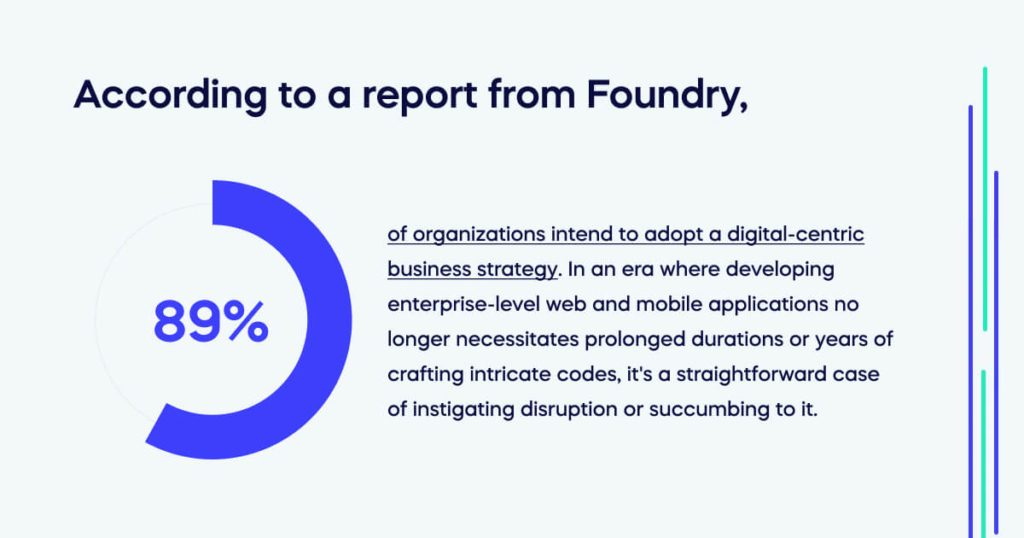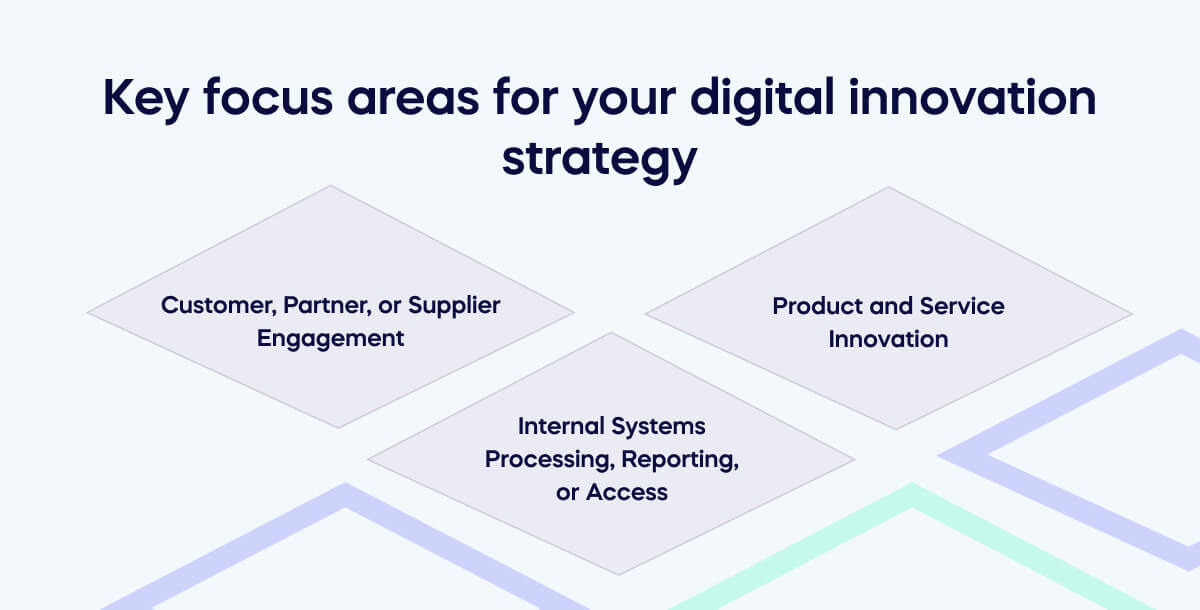What Is Digital Innovation?
Digital innovation is the application and adoption of digital technologies in a strategic manner to improve business operations, create novel products or services, enhance customer interactions, and meet evolving market demands.
It’s essentially a systemic overhaul that disrupts traditional methods and fosters competitive differentiation. Ideas such as digital transformation and digitization are closely related to the concept of digital innovation.
Digital innovation is facilitated by advanced technologies, including artificial intelligence (AI), big data analytics, and cloud computing. It uses these technological resources to discover new opportunities and fuel growth for businesses or organizations, focusing on making the most of the tools and systems already in place.

It’s worth remembering that digital innovation isn’t just about technology – it’s about smartly leveraging technology for maximum benefit. The most successful digital innovators are those who recognize that the competitive landscape is constantly changing and do what they can to stay ahead of the curve.
However, it’s important to note that digital innovation is an iterative process – a continuous journey of discovery and learning. The only way to keep up with the ever-changing landscape is to remain curious, experiment, and stay open-minded.
It’s also essential to have the right tools in place to create an environment where digital innovation can flourish.
Why is digital innovation important?

Organizations face the peril of obsolescence if they fail to implement digital innovation or adjust to the dynamic consumer and business practices.
According to a report from Foundry, 89% of organizations intend to adopt a digital-centric business strategy. In an era where developing enterprise-level web and mobile applications no longer necessitates prolonged durations or years of crafting intricate codes, it’s a straightforward case of instigating disruption or succumbing to it.

Digital innovation has emerged as a crucial element in the contemporary business environment, owing to several compelling reasons:
- Competitive Differentiation: Digital innovation serves as a conduit for businesses to establish a robust competitive advantage. Through the strategic deployment of novel technologies, organizations can introduce distinctive products and services that set them apart from the competition, thereby securing a formidable market position.
- Organizational Effectiveness: One of the substantial benefits of digital innovation is the enhancement of organizational effectiveness. Organizations can dramatically reduce the time and resources typically required by replacing traditional processes with automated workflows and digital tools, thereby increasing productivity.
- Advanced Customer Engagement: Digital innovation plays a pivotal role in enriching the customer experience. Sophisticated tools such as AI-driven chatbots, customized marketing initiatives, and intuitive mobile applications facilitate more interactive and personalized customer engagements. This not only improves customer satisfaction but also promotes loyalty.
- Data-Driven Strategic Planning: The advent of digital innovation introduces businesses to the power of data analytics. By harnessing this capability, organizations can make strategic decisions based on real-time, data-driven insights, enhancing business performance and forecasting accuracy.
- Innovation Culture: Digital innovation fosters a culture of continuous improvement and innovation within the organization. It encourages employees to think outside the box, experiment with new ideas, and embrace change, thereby driving innovation at all levels of the organization.
- Business Model Transformation: Companies can revolutionize and reshape their business structures through digital innovation. Utilizing digital technologies allows for the creation of fresh revenue avenues, enhancement of service provision, and redefinition of their unique selling proposition.
Who is digital innovation for?
Digital innovation is not confined to any particular group; it’s relevant and beneficial for everyone, from individuals to businesses and even governments.
For Individuals
Digital innovation has the power to simplify daily tasks. From online banking to grocery shopping, digital tools have made life more convenient. Furthermore, communication has been enhanced with the advent of social media platforms and instant messaging apps, making it easier than ever to stay connected with friends and family.
Personal growth is also facilitated through digital innovation. Online learning platforms offer a plethora of courses and resources, allowing individuals to acquire new skills or knowledge from the comfort of their homes.
For Businesses
Businesses of all sizes and across all sectors can harness digital innovation to boost operational efficiency. Digital tools can automate repetitive tasks, streamline workflows, and improve data management, thereby increasing productivity and reducing costs.
Innovation in digital technology also allows businesses to develop new products or services. For example, AI and machine learning can be used to analyze customer behavior and predict market trends, helping companies to stay ahead of the competition.
For Governments
Government entities can significantly benefit from digital innovation by improving public service delivery. Digital platforms can make processes like tax filing, license renewals, and applications for public services faster and more efficient.
Digital innovation also facilitates effective citizen engagement. Social media platforms, mobile apps, and websites allow governments to communicate important information, gather citizen feedback, and foster transparency.
For the Education Sector
Digital innovation has revolutionized education by making learning more accessible. Online classes, digital textbooks, and educational apps have broken down geographical barriers, allowing anyone with internet access to pursue learning opportunities.
It also promotes inclusivity by providing personalized learning experiences to cater to different learning styles and needs. Assistive technologies enable learners with disabilities to participate in educational activities, leveling the playing field for all students.

Digital innovation Vs. digital transformation
Although often used interchangeably, digital innovation and digital transformation represent distinct concepts in the realm of technology. Both are crucial for businesses aiming to enhance their processes and stay competitive in today’s digital age.
Let’s start with a clear definition for both:
Digital Innovation
Digital innovation refers to the creation and implementation of novel digital technologies or the innovative use of existing ones. It involves developing new services, products, or business models that leverage digital technologies.
Digital innovation is a testing ground for new ideas on a smaller scale, providing immediate value and learning opportunities. For instance, a company might innovate by developing a new mobile app to improve customer engagement or utilizing big data analytics to gain insights into market trends.
Digital Transformation
Digital transformation is a broader, more strategic initiative. It represents a fundamental change in how a business operates, integrating digital technology into all areas of the organization.
This process often involves a shift in company culture, requiring businesses to challenge the status quo and experiment with new ways of working. Digital transformation aims to improve the efficiency of business processes, enhance customer experience, and enable new business models.
For example, a traditional retail business undergoing digital transformation might transition to an e-commerce model, implementing digital payment systems, online customer service, and digital marketing strategies.
So what’s the main difference between the two?
The main difference between digital innovation and digital transformation lies in their scope and scale. While digital innovation focuses on specific areas or projects, digital transformation involves a holistic change in the organization’s operations and mindset.
Businesses can leverage digital innovation and transformation to enhance their technology processes. Digital innovation allows companies to experiment with new ideas and technologies on a smaller scale, learning from the outcomes and gradually implementing successful innovations.
Meanwhile, digital transformation provides a strategic roadmap for comprehensive digital integration, driving long-term growth and competitiveness. Together, they create a dynamic digital ecosystem that fosters continuous improvement and adaptation in the face of technological advancements.
Three examples of digital innovation in action
It’s easy to get caught up in abstract concepts, so let’s look at three real-world examples of digital innovation to bring the idea to life.
- IKEA: IKEA’s innovative approach to digital transformation is showcased through its AR-powered application, IKEA Place. The app, developed using Apple’s ARKit framework, allows customers to virtually place life-sized 3D models of IKEA’s furniture in their homes. The app uses the device’s camera and taps into complex algorithms for depth perception and light estimation, making the virtual furniture appear as realistic as possible within the space. This use of AR technology not only enhances the customer experience by enabling them to visualize products in their environment before buying and helps reduce return rates, driving operational efficiency.
- LEGO: LEGO’s digital transformation strategy bridges the gap between physical and digital play, creating a well-rounded consumer experience. One significant step was introducing the LEGO Tower mobile game, developed in collaboration with NimbleBit. The game leverages the Unity engine for rendering 3D graphics and Firebase for back-end services like authentication, database, and analytics. Additionally, they launched LEGO Fusion, a product line that combines traditional building with interactive mobile gameplay. The Fusion sets include special bricks that can be scanned via an app (using image recognition technology), rendering a digital version of the built structure in the game.
- Starbucks: Starbucks’ digital transformation journey is a testament to how data-driven decision-making can revolutionize a business. A key part of this strategy is their mobile order & pay app, developed using Node.js for the backend and React Native for cross-platform mobile development. This system has not only expedited the ordering process but also generated a wealth of data about customer preferences. Furthermore, they have a sophisticated loyalty program powered by AI and machine learning algorithms, which analyze customers’ purchasing habits and personalize marketing campaigns accordingly. This personalization has significantly increased customer engagement and loyalty.

Key focus areas for your digital innovation strategy
Now that you have a grasp of the concept of digital innovation let’s explore how to put it into practice. A well-executed digital innovation strategy encompasses three key areas that demand attention: customer, partner, or supplier engagement:
- Customer, partner, or supplier engagement
- Product and service innovation
- Internal systems processing, reporting, or access
Customer, Partner, or Supplier Engagement
Digital innovation strategies can significantly enhance engagement with customers, partners, and suppliers. Businesses can improve customer experiences by leveraging cutting-edge technologies like AI and machine learning, enabling them to create a personalized, interactive, and ultimately, more satisfying journey for their customers.
For instance, chatbots can provide real-time assistance, while predictive analytics can offer personalized product recommendations. Similarly, digital platforms can improve partner and supplier collaboration by providing real-time access to data, facilitating faster decision-making, and promoting transparency. A robust Customer Relationship Management (CRM) system can also streamline interactions, fostering stronger relationships.
Product and Service Innovation
In the era of digitalization, businesses must constantly innovate their products and services to maintain a competitive edge. Emerging technologies such as IoT, AR/VR, and blockchain have the potential to revolutionize and redefine product offerings, paving the way for enhanced customer experiences and market success.
The Internet of Things (IoT) empowers smart home products, augmented reality/virtual reality (AR/VR) creates captivating gaming experiences, and blockchain ensures secure financial transactions. Furthermore, harnessing the power of cloud computing and artificial intelligence (AI) paves the way for innovative service models such as Software-as-a-Service (SaaS), elevating scalability and efficiency to new heights.
Internal Systems Processing, Reporting, or Access
Digital innovation can optimize internal processes, reporting, and data access. Implementing automation and AI can streamline workflows, reducing manual labor and improving accuracy.
Data analytics tools can transform raw data into actionable insights, enabling informed decision-making. Furthermore, cloud-based solutions can provide secure, remote access to systems and data, promoting flexibility and collaboration. Upgrading to digital HR systems can automate payroll and leave management tasks, freeing up resources for strategic initiatives.

The digital innovation supply chain
The “Digital Innovation Supply Chain” is a strategic process that guides businesses from the initial idea stage to market release. It encompasses planning, sourcing, development, and distribution, forming the backbone of digital transformation efforts.
Let’s examine each phase closely.
- Plan: This phase involves strategic planning and identification of innovation opportunities. It requires comprehensive market research, technology trend analysis, and alignment of these insights with organizational capabilities.
- Source: In this phase, businesses procure necessary resources for innovation. This could include acquiring cutting-edge technologies, establishing strategic partnerships, or recruiting talent with specific skill sets.
- Develop: This stage is characterized by transforming innovative ideas into tangible solutions. It involves technical processes such as software development, prototype creation, system integration, testing, and debugging.
- Distribute: The final phase involves the delivery of the digital solution to the target market. This includes product deployment, user training, providing post-launch support, and setting up feedback mechanisms for continuous improvement.

Each phase of the digital innovation supply chain is interconnected, requiring seamless collaboration and a unified vision to successfully drive digital transformation.


